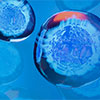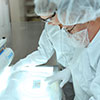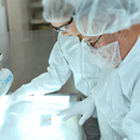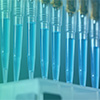PendoTech®+Single-Use+Sensors
Artikel-Nr:
(BOSSBS-13726R-A680)
Lieferant:
Bioss
Hersteller-Artikelnummer::
BS-13726R-A680
Lokale Artikelnummer::
BOSSBS-13726R-A680
Beschreibung:
Protocadherins are a large family of cadherin-like cell adhesion proteins that are involved in the establishment and maintenance of neuronal connections in the brain. There are three protocadherin gene clusters, designated alpha, beta and gamma, all of which contain multiple tandemly arranged genes. PCDHB6 (Protocadherin beta-6) is a 794 amino acid single pass transmembrane protein that is one of 16 proteins in the protocadherin beta cluster. Unlike the alpha and gamma gene clusters whose genes are spliced to downstream constant region exons during transcription, members of the beta cluster (such as PCDHB6) do not use constant-region exons to produce mRNAs. As a result, each protocadherin beta gene encodes the transmembrane, extracellular and short cytoplasmic domains of the protein. PCDHB6 is likely a calcium-dependent cell adhesion protein that is involved in the maintenance of neural connections in the brain. Unlike most protocadherin-beta proteins, PCDHB6 has not one but two PXXP motifs within its cytoplasmic domain, suggesting a role in signal transduction cascade events.
VE:
1 * 100 µl
Artikel-Nr:
(BOSSBS-7651R-FITC)
Lieferant:
Bioss
Hersteller-Artikelnummer::
BS-7651R-FITC
Lokale Artikelnummer::
BOSSBS-7651R-FITC
Beschreibung:
Deoxyribonuclease I gene is approximately 3.2 kb long with 9 exons separated by 8 introns. In the form of a bovine pancreatic enzyme preparation, it occupies an important place in the history of protein chemistry and enzymology: it was the first enzyme to be recognized as specific for DNA; it was the first DNase to be crystallized; and it was the first DNase for which a specific protein inhibitor was characterized. DNase I is a Ca2+ and Mg2+ dependant endonuclease. DNase I is synthesized in the pancreas and stored in zymogen granules. It has been used to reduce the viscosity of cystic fibrosis sputum. A DNase I-like enzyme appears to catalyze the degradation of chromatin to oligo- and mononucleosomes during apoptosis. A recent study has demonstrated an endonuclease with activity and antigenicity indistinguishable from DNase I in thymocytes, cells susceptible to apoptosis. DNase I is an endonuclease that hydrolyzes double-stranded or single stranded DNA preferentially at sites adjacent to pyrimidine nucleotides. The product of hydrolysis is a complex mixture of 5'-phosphate mononucleotides and oligonucleotides. In the presence of Mg ion, DNase I attacks each strand of DNA independently and the cleavage sites are random.
VE:
1 * 100 µl
Artikel-Nr:
(BOSSBS-7651R-A350)
Lieferant:
Bioss
Hersteller-Artikelnummer::
BS-7651R-A350
Lokale Artikelnummer::
BOSSBS-7651R-A350
Beschreibung:
Deoxyribonuclease I gene is approximately 3.2 kb long with 9 exons separated by 8 introns. In the form of a bovine pancreatic enzyme preparation, it occupies an important place in the history of protein chemistry and enzymology: it was the first enzyme to be recognized as specific for DNA; it was the first DNase to be crystallized; and it was the first DNase for which a specific protein inhibitor was characterized. DNase I is a Ca2+ and Mg2+ dependant endonuclease. DNase I is synthesized in the pancreas and stored in zymogen granules. It has been used to reduce the viscosity of cystic fibrosis sputum. A DNase I-like enzyme appears to catalyze the degradation of chromatin to oligo- and mononucleosomes during apoptosis. A recent study has demonstrated an endonuclease with activity and antigenicity indistinguishable from DNase I in thymocytes, cells susceptible to apoptosis. DNase I is an endonuclease that hydrolyzes double-stranded or single stranded DNA preferentially at sites adjacent to pyrimidine nucleotides. The product of hydrolysis is a complex mixture of 5'-phosphate mononucleotides and oligonucleotides. In the presence of Mg ion, DNase I attacks each strand of DNA independently and the cleavage sites are random.
VE:
1 * 100 µl
Artikel-Nr:
(BSENR-1405-50)
Lieferant:
Biosensis
Hersteller-Artikelnummer::
R-1405-50
Lokale Artikelnummer::
BSENR-1405-50
Beschreibung:
Ubiquitin is a highly conserved 76 amino acid protein with an estimated molecular weight of 8.56 kDa which has a central role in regulated protein degradation. It is a protein modifier which can be covalently attached to target lysines either as a monomer or as a lysine-linked polymer. Several types of polymeric chains can be formed depending on the lysine used for the assembly. Attachment to proteins as a polymer leads to their degradation by the 26S proteosome; a complex, multicatalytic cytosolic and nuclear protease. Attachment to proteins as a monomer or as an alternatively linked polymer does not lead to proteasomal degradation and may be required for numerous functions, including maintenance of chromatic structure, regulation of gene expression, stress response, ribosome biogenesis and DNA repair. Ubiquitin is synthesized as a polyubiquitin precursor with exact head to tail repeats, the number of repeats of which differ between species and strains. In some species there is a final amino-acid after the last repeat, here in bovine a Cys. Some ubiquitin genes contain a single copy of ubiquitin fused to a ribosomal protein (either L40 or S27a).
VE:
1 * 50 µl
Lieferant:
VWR Collection
Beschreibung:
Diese digitalen Messgeräte vereinen sechs Parameter in einem Gerät: pH, mV, Temperatur, Leitfähigkeit, , Gelöstsauerstoff und Trübung. Die IDP-Technologie optimiert die Anwendung und erleichtert die Messung (keine Neukalibrierung bei Wechsel des Messgeräts und keine Anpassung der Einstellungen des Messgeräts erforderlich). Die Messdaten beinhalten Seriennummer, Einstellungen und Kalibrierdaten.
Lieferant:
Biotium
Beschreibung:
This MAb recognizes the double stranded DNA in human cells. It can be used to stain the nuclei in cell or tissue preparations and can be used as a nuclear marker in human cells. This MAb produces a homogeneous staining pattern in the nucleus of normal and malignant cells. Deoxyribonucleic acid (DNA) is a nucleic acid that stores long-term information regarding the development and function of all known living organisms. DNA consists of two long nucleotide polymers, which are composed of four bases, namely adenine, thymine, guanine and cytosine, all of which are flanked by a phosphate-deoxyribose backbone. Normally, DNA exists as a double-stranded (ds) molecule that forms in the shape of a double helix, allowing the bases and the backbone of the two strands to interact, thus forming a polynucleotide. When the double helix is unwound (either by enzymes or heat), DNA exists as a single-stranded (ss) molecule that is less stable than the double helix, but is necessary for protein access to DNA bases. Double stranded DNA markers are useful tools in biology research and aid in the study of DNA behavior and characteristics.
Artikel-Nr:
(BOSSBS-9201R-CY5)
Lieferant:
Bioss
Hersteller-Artikelnummer::
BS-9201R-CY5
Lokale Artikelnummer::
BOSSBS-9201R-CY5
Beschreibung:
IGSF11 is also known as BTIGSF (brain and testis-specific immunoglobulin superfamily protein) or VSIG3 (V-set and immunoglobulin domain-containing protein 3) and is a 431 amino acid protein that is expressed as three isoforms. IGSF11 is highly expressed in testis and ovary and is also expressed in brain, kidney and skeletal muscle, localized to the cellular membrane as a single-pass membrane protein. IGSF11 is an immunoglobulin with V-type and C2-type domains that function in molecular recognition. When IGSF11 is in the trans position, it plays an important role in cell-cell adhesion via both homophilic and heterophilic interactions with other molecules. These cell–cell interactions are also thought to be important for neuronal cell interactions, such as neuron–neuron or neuron–glia interactions, which are important for the development and function of the central nervous system. In addition, IGSF11 might also be involved interactions between Sertoli cells and spermatocytes, which are important associations during spermatogenesis. The IGSF11 gene is commonly upregulated in gastric cancer and IGSF11 is highly expressed in many types of human tumors, indicating that it may be useful as a target for immunotherapy.
VE:
1 * 100 µl
Artikel-Nr:
(BOSSBS-9201R-A555)
Lieferant:
Bioss
Hersteller-Artikelnummer::
BS-9201R-A555
Lokale Artikelnummer::
BOSSBS-9201R-A555
Beschreibung:
IGSF11 is also known as BTIGSF (brain and testis-specific immunoglobulin superfamily protein) or VSIG3 (V-set and immunoglobulin domain-containing protein 3) and is a 431 amino acid protein that is expressed as three isoforms. IGSF11 is highly expressed in testis and ovary and is also expressed in brain, kidney and skeletal muscle, localized to the cellular membrane as a single-pass membrane protein. IGSF11 is an immunoglobulin with V-type and C2-type domains that function in molecular recognition. When IGSF11 is in the trans position, it plays an important role in cell-cell adhesion via both homophilic and heterophilic interactions with other molecules. These cell–cell interactions are also thought to be important for neuronal cell interactions, such as neuron–neuron or neuron–glia interactions, which are important for the development and function of the central nervous system. In addition, IGSF11 might also be involved interactions between Sertoli cells and spermatocytes, which are important associations during spermatogenesis. The IGSF11 gene is commonly upregulated in gastric cancer and IGSF11 is highly expressed in many types of human tumors, indicating that it may be useful as a target for immunotherapy.
VE:
1 * 100 µl
Artikel-Nr:
(BOSSBS-9201R-A488)
Lieferant:
Bioss
Hersteller-Artikelnummer::
BS-9201R-A488
Lokale Artikelnummer::
BOSSBS-9201R-A488
Beschreibung:
IGSF11 is also known as BTIGSF (brain and testis-specific immunoglobulin superfamily protein) or VSIG3 (V-set and immunoglobulin domain-containing protein 3) and is a 431 amino acid protein that is expressed as three isoforms. IGSF11 is highly expressed in testis and ovary and is also expressed in brain, kidney and skeletal muscle, localized to the cellular membrane as a single-pass membrane protein. IGSF11 is an immunoglobulin with V-type and C2-type domains that function in molecular recognition. When IGSF11 is in the trans position, it plays an important role in cell-cell adhesion via both homophilic and heterophilic interactions with other molecules. These cell–cell interactions are also thought to be important for neuronal cell interactions, such as neuron–neuron or neuron–glia interactions, which are important for the development and function of the central nervous system. In addition, IGSF11 might also be involved interactions between Sertoli cells and spermatocytes, which are important associations during spermatogenesis. The IGSF11 gene is commonly upregulated in gastric cancer and IGSF11 is highly expressed in many types of human tumors, indicating that it may be useful as a target for immunotherapy.
VE:
1 * 100 µl
Artikel-Nr:
(BOSSBS-13727R-CY5)
Lieferant:
Bioss
Hersteller-Artikelnummer::
BS-13727R-CY5
Lokale Artikelnummer::
BOSSBS-13727R-CY5
Beschreibung:
Protocadherins are a large family of cadherin-like cell adhesion proteins that are involved in the establishment and maintenance of neuronal connections in the brain. There are three protocadherin gene clusters, designated alpha, beta and gamma, all of which contain multiple tandemly arranged genes. PCDHB14 (Protocadherin beta 14) is a 798 amino acid protein that is one of 16 proteins in the protocadherin beta cluster. Unlike the alpha and gamma gene clusters whos genes are spliced to downstream constant region exons during transcription, members of the beta cluster (such as PCDHB14) do not use constant-region exons to produce mRNAs. As a result, each protocadherin beta gene encodes the transmembrane, extracellular and short cytoplasmic domains of the protein. Localized to the cell membrane, PCDHB14 is a single-pass type I membrane protein that contains six cadherin domains.
VE:
1 * 100 µl
Artikel-Nr:
(BOSSBS-13725R-A647)
Lieferant:
Bioss
Hersteller-Artikelnummer::
BS-13725R-A647
Lokale Artikelnummer::
BOSSBS-13725R-A647
Beschreibung:
Protocadherins are a large family of cadherin-like cell adhesion proteins that are involved in the establishment and maintenance of neuronal connections in the brain. There are three protocadherin gene clusters, designated a, b and g, all of which contain multiple tandemly-arranged genes. PCDHB10 (protocadherin b10), also known as PCHB10 or PCDH-b10, is an 800 amino acid protein that is one of 16 proteins in the protocadherin b cluster. Unlike the a and g gene clusters, whose genes are spliced to downstream constant-region exons during transcription, members of the b cluster (such as PCDHB10) do not use constant-region exons to produce mRNAs. As a result, each protocadherin b gene encodes the transmembrane, extracellular and short cytoplasmic domains of the protein. Localized to the cell membrane, PCDHB10 is a single-pass type I membrane protein that contains six cadherin domains.
VE:
1 * 100 µl
Artikel-Nr:
(BOSSBS-13724R-A750)
Lieferant:
Bioss
Hersteller-Artikelnummer::
BS-13724R-A750
Lokale Artikelnummer::
BOSSBS-13724R-A750
Beschreibung:
Protocadherins are a large family of cadherin-like cell adhesion proteins that are involved in the establishment and maintenance of neuronal connections in the brain. There are three protocadherin gene clusters, designated alpha, beta and gamma, all of which contain multiple tandemly arranged genes. PCDHB1 (Protocadherin beta 1) is an 818 amino acid protein that is one of 16 proteins in the protocadherin beta cluster. Unlike the alpha and gamma gene clusters whose genes are spliced to downstream constant region exons during transcription, members of the beta cluster (such as PCDHB1) do not use constant-region exons to produce mRNAs. As a result, each protocadherin beta gene encodes the transmembrane, extracellular and short cytoplasmic domains of the protein. PCDHB1 is a single-pass type I membrane protein containing six cadherin domains.
VE:
1 * 100 µl
Artikel-Nr:
(BOSSBS-13727R-A555)
Lieferant:
Bioss
Hersteller-Artikelnummer::
BS-13727R-A555
Lokale Artikelnummer::
BOSSBS-13727R-A555
Beschreibung:
Protocadherins are a large family of cadherin-like cell adhesion proteins that are involved in the establishment and maintenance of neuronal connections in the brain. There are three protocadherin gene clusters, designated alpha, beta and gamma, all of which contain multiple tandemly arranged genes. PCDHB14 (Protocadherin beta 14) is a 798 amino acid protein that is one of 16 proteins in the protocadherin beta cluster. Unlike the alpha and gamma gene clusters whos genes are spliced to downstream constant region exons during transcription, members of the beta cluster (such as PCDHB14) do not use constant-region exons to produce mRNAs. As a result, each protocadherin beta gene encodes the transmembrane, extracellular and short cytoplasmic domains of the protein. Localized to the cell membrane, PCDHB14 is a single-pass type I membrane protein that contains six cadherin domains.
VE:
1 * 100 µl
Artikel-Nr:
(BOSSBS-13727R-A488)
Lieferant:
Bioss
Hersteller-Artikelnummer::
BS-13727R-A488
Lokale Artikelnummer::
BOSSBS-13727R-A488
Beschreibung:
Protocadherins are a large family of cadherin-like cell adhesion proteins that are involved in the establishment and maintenance of neuronal connections in the brain. There are three protocadherin gene clusters, designated alpha, beta and gamma, all of which contain multiple tandemly arranged genes. PCDHB14 (Protocadherin beta 14) is a 798 amino acid protein that is one of 16 proteins in the protocadherin beta cluster. Unlike the alpha and gamma gene clusters whos genes are spliced to downstream constant region exons during transcription, members of the beta cluster (such as PCDHB14) do not use constant-region exons to produce mRNAs. As a result, each protocadherin beta gene encodes the transmembrane, extracellular and short cytoplasmic domains of the protein. Localized to the cell membrane, PCDHB14 is a single-pass type I membrane protein that contains six cadherin domains.
VE:
1 * 100 µl
Artikel-Nr:
(BOSSBS-13727R-A647)
Lieferant:
Bioss
Hersteller-Artikelnummer::
BS-13727R-A647
Lokale Artikelnummer::
BOSSBS-13727R-A647
Beschreibung:
Protocadherins are a large family of cadherin-like cell adhesion proteins that are involved in the establishment and maintenance of neuronal connections in the brain. There are three protocadherin gene clusters, designated alpha, beta and gamma, all of which contain multiple tandemly arranged genes. PCDHB14 (Protocadherin beta 14) is a 798 amino acid protein that is one of 16 proteins in the protocadherin beta cluster. Unlike the alpha and gamma gene clusters whos genes are spliced to downstream constant region exons during transcription, members of the beta cluster (such as PCDHB14) do not use constant-region exons to produce mRNAs. As a result, each protocadherin beta gene encodes the transmembrane, extracellular and short cytoplasmic domains of the protein. Localized to the cell membrane, PCDHB14 is a single-pass type I membrane protein that contains six cadherin domains.
VE:
1 * 100 µl
Artikel-Nr:
(BOSSBS-13727R-A680)
Lieferant:
Bioss
Hersteller-Artikelnummer::
BS-13727R-A680
Lokale Artikelnummer::
BOSSBS-13727R-A680
Beschreibung:
Protocadherins are a large family of cadherin-like cell adhesion proteins that are involved in the establishment and maintenance of neuronal connections in the brain. There are three protocadherin gene clusters, designated alpha, beta and gamma, all of which contain multiple tandemly arranged genes. PCDHB14 (Protocadherin beta 14) is a 798 amino acid protein that is one of 16 proteins in the protocadherin beta cluster. Unlike the alpha and gamma gene clusters whos genes are spliced to downstream constant region exons during transcription, members of the beta cluster (such as PCDHB14) do not use constant-region exons to produce mRNAs. As a result, each protocadherin beta gene encodes the transmembrane, extracellular and short cytoplasmic domains of the protein. Localized to the cell membrane, PCDHB14 is a single-pass type I membrane protein that contains six cadherin domains.
VE:
1 * 100 µl
Preis auf Anfrage
Lager für diesen Artikel ist begrenzt, kann aber in einem Lagerhaus in Ihrer Nähe zur Verfügung. Bitte stellen Sie sicher, dass Sie in sind angemeldet auf dieser Seite, so dass verfügbare Bestand angezeigt werden können. Wenn das
Lager für diesen Artikel ist begrenzt, kann aber in einem Lagerhaus in Ihrer Nähe zur Verfügung. Bitte stellen Sie sicher, dass Sie in sind angemeldet auf dieser Seite, so dass verfügbare Bestand angezeigt werden können. Wenn das
Dieses Produkt kann nur an eine Lieferadresse versandt werden die über die entsprechende Lizenzen verfügt. Für weitere Hilfe bitte kontaktieren Sie Ihr VWR Vertriebszentrum.
-Additional Documentation May be needed to purchase this item. A VWR representative will contact you if needed.
Dieses Produkt wurde von Ihrer Organisation gesperrt. Bitte kontaktieren Sie Ihren Einkauf für weitere Informationen.
Dieses Produkt ist Ersatz für den von Ihnen gewünschten Artikel.
Dieses Produkt ist nicht mehr verfügbar. Bitte kontaktieren Sie den VWR Kundenservice.
|
|||||||||

















































